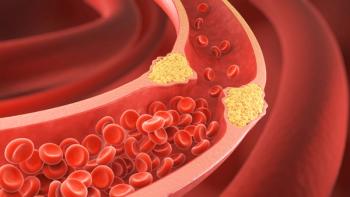
Diagnostic and Treatment Considerations for Splanchnic Vein Thrombosis in MPN
The review highlighted key diagnostic and treatment considerations for patients with splanchnic vein thrombosis and myeloproliferative neoplasms.
Splanchnic vein thromboses (SVTs) can be secondary to various conditions, but the significant association between SVTs and myeloproliferative neoplasms (MPNs) warrants further research, a
SVTs are venous thromboembolisms involving abdominal vessels, including portal, hepatic, splenic, and mesenteric veins. While there are several non-hematological conditions associated with SVTs, they also occur secondary to hematological conditions, including MPNs. There is a strong association between SVTs and MPNs, which are chronic hematological malignancies driven by clonal myeloid cell proliferation.
The review highlighted key diagnostic and treatment considerations for patients with MPN-SVT and recommended further research directions to improve the understanding of this complication.
Patients with Philadelphia chromosome-negative MPNs—including polycythemia vera (PV), essential thrombocythemia, and primary myelofibrosis—are especially likely to experience venous thrombosis overall than the general population. They are also at a much higher risk of SVT. Approximately 5% of patients with portal vein thrombosis and 25-50% of patients diagnosed with Budd-Chiari syndrome are also found to have an MPN at disease onset or develop one later, and approximately one-third of patients diagnosed with MPNs show evidence of chronic SVT.
“Despite this established association, an MPN diagnosis is frequently delayed or missed for several reasons. One of the most important reasons that MPN is not diagnosed is because the SVT may be the sole manifestation of MPN. In addition, bleeding, hypersplenism, and hemodilution can mask the abnormal blood count levels that often alert clinicians to the presence of an underlying MPN,” the authors wrote.
Patients diagnosed with MPN-SVT are typically younger relative to the general population of patients with thrombosis outside of the splanchnic bed. In one cohort of 204 PV patients, all types of thrombosis except SVT had similar rates in older and younger patients. SVT, however, was seen in 13% of patients under 45 years old and 2% of patients 65 years or older. The authors note that the best modalities for SVT identification are contrast-enhanced CT or MRI versus ultrasound with Doppler imaging.
While hematocrit levels are typically associated with thrombosis in patients with MPN, evidence suggests that factors aside from hematological measures may impact SVT risk in these patients. For example, MPN patients with previous SVT were often found to have JAK2V617F-positive endothelial cells, which may lead to increased cell adhesion and coagulation, in several studies. Additional signaling pathways may also play a part in SVT risk, but research into potential risk-reducing targets is needed.
“Particularly in the case of non-cirrhotic SVT, evaluation for an MPN should be performed in all patients with an SVT regardless of hematologic manifestations,” the authors wrote. “Data supporting this recommendation is derived from a meta-analysis that analyzed SVT patients without hematologic features of MPN (i.e., elevations in peripheral blood count).”
When an SVT does not have a clear cause, fully evaluating patients for MPNs and to confirm the subtype of MPN should include a bone marrow biopsy when an MPN driver mutation, hematological signs, or clinical symptoms are present. In some cases, the subtype of MPN may be unclear and the diagnosis can be MPN unclassifiable (MPN-U). In SVT that is clearly the result of a commonly associated condition or procedure, it may not be necessary to pursue testing for MPNs.
Prompt anticoagulation therapy is currently the main therapy strategy for MPN-SVT, but there is little data on the optimal management of the condition. Overall, the authors emphasize the importance of an experienced multidisciplinary care team working collaboratively to care for patients with MPN-SVT.
Endovascular interventions such as transjugular intrahepatic portosystemic shunts should be considered when anticoagulation therapy alone is not sufficient to decompress vessels in a timely manner. In patients with Budd-Chiari syndrome, this type of intervention is typically necessary to relieve pressure in the portal vasculature and prevent liver failure. MPN-directed cytoreductive therapies have also been explored in MPN-SVT, but there is a lack of definitive evidence to define the role of cytoreduction in this patient population.
Overall, there is a lack of definitive evidence to determine the optimal treatment strategy for patients with MPN-SVT, although anticoagulation therapy is beneficial in most cases. Targeted studies involving multidisciplinary research teams are still needed to clarify risk factors, recurrence patterns, and effective interventions.
“Ideally, prospective evaluation involving multiple centers (given the rarity of this condition) is needed to clarify the role of new therapies and fully evaluate additional management strategies that can inform the future treatment of MPN-SVT,” the authors wrote.
Reference
Tremblay D, Winters A, Beckman JD, et al. Splanchnic vein thrombosis associated with myeloproliferative neoplasms. Thromb Res. Published online August 5, 2022. doi:10.1016/j.thromres.2022.08.003
Newsletter
Stay ahead of policy, cost, and value—subscribe to AJMC for expert insights at the intersection of clinical care and health economics.








